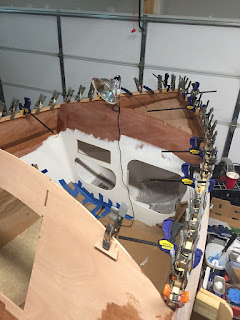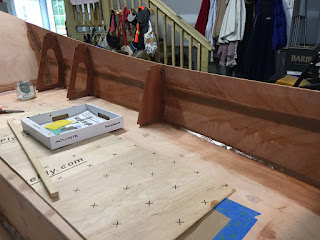Below you can see some of the pictures of the standard stringers and some of the additional stringers I installed. Below shows one of the stringers that will help support the seatback on the transom.
Below is a picture of the stringers after I leveled them out using a plane. This was actually a lot easier than I thought when I first started todo this area. I used a chisel to get the edges closest to the rear cabin wall and transom.
I used a clamp on the top of the piece, but had to us a screw on the bottom. Be careful not to drill through!! :)
The manual calls for blocking to be place in 3 places on each side. They will support the hardware block you will install last. I was able to cut the blocking and plane it so it fit properly. I opt'd to go with thicker blocking based on some of the other blogs I read. In the manual, it looks like they used another piece of Okoume plywood.
Below I am dry fitting the pieces and using a plane on the edges to make sure they fit properly. I will apply multiple coats of epoxy to seal them up before glueing them in place.
Below of the pieces of blocking I am using. I have one coat on them and the epoxy is curing.
Below is the transom skirt. I have been playing with it for about a week looking at the best way to install it. The manual shows the inside edge of the skirt flush/even with the inside edge of the transom. Pg. 176 shows a good picture of how to install it.
I did a dry fit and got it close to where I wanted to install it. I then drilled one hole through the skirt into the blocking on both sides. I used a finishing nail the same size as the holes and laid down a large bead of epoxy from a pastry bag. I used the nails to line things up on both sides and then just pushed the skirt down. It slides on the nails and goes right into place. I think this method helps, so you are not sliding the piece and getting epoxy all over the place. I did have to use a brush to move the epoxy, because I could not see the pilot holes for the nails to go in. I then drilled some additional holes and used drywall screws to hold in place. I was actually very pleased with the way it turned out. I took a fine tooth saw and cut the extra piece of wood on the edges off, so they are flush with the sides.
I wanted some weight in the middle of the skirt to hold it down, so I used clamps to hold weights in place.
Another shot of everything glued/clamped in place. On the starboard side I broke the glue joint playing with the blocking, so I had to re-epoxy the piece in place. I used a screw through the transom skirt to hold it in place. I hope this holds. I think I will leave it there until I get the blocking glued in.
Below is the skirt in place with the epoxy fillet on the inside. This will need to be sanded smooth, since I still can't do fillets very well. Oh well I like sanding!
I started on the seatbacks and epoxied the flanges into place. Below is a couple of pictures.
I have cut out the holes, but still need to use my router to do a round over on the edges.
Things are slowly coming along.




































